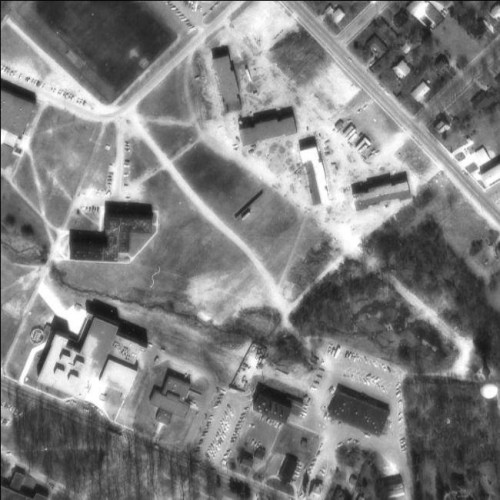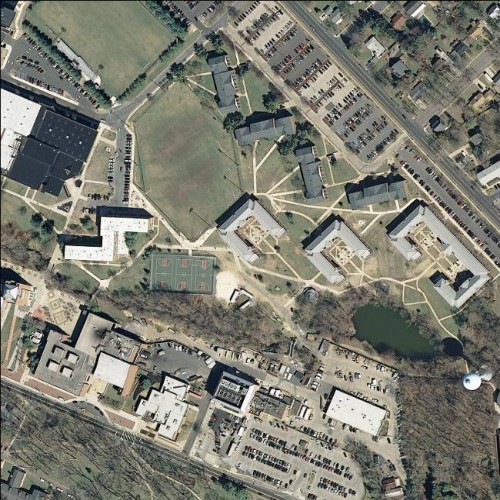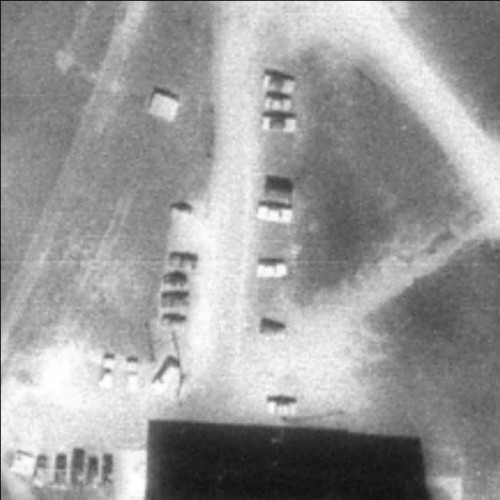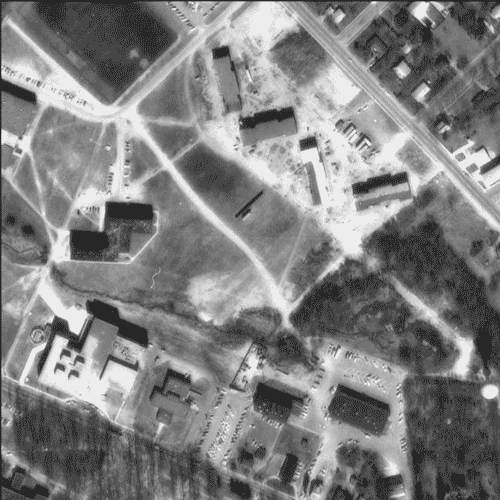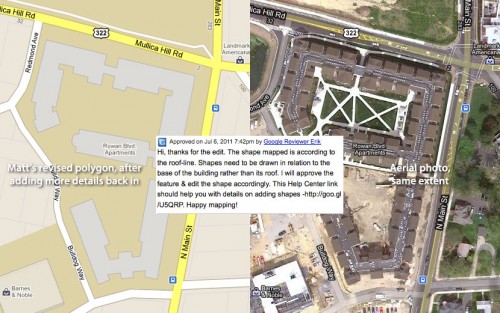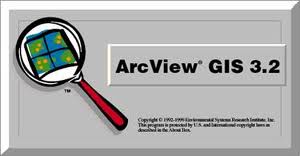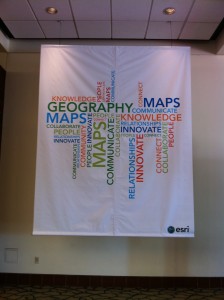I originally wrote the following approximately two weeks ago and it has been lingering as a Draft until now. I decided to wait until the start of the Esri International User Conference to publish this post. The UC has several events planned for their community mapping offerings, here’s my take on how Google’s approach has been less than impressive. Part 2 to follow available here.
Way, way back in March of 2010, I contacted Google through their Map Content Partners form to submit Rowan University’s GIS data to be included on Google Maps. I heard nothing from them – not even an automated response – for several months. In August of 2010, someone in Administration noticed that Google had relabeled Rowan University as Glassboro State College, a name not used since 1992. I was instructed to try and remedy this as soon as possible. I explained that Google had given me the cold shoulder, but I would try some different avenues. The “report a problem” feature in Google Maps did get “Glassboro State College” off the map, but Rowan remained a featureless blotch within Glassboro.
After giving up on contributing data to Google Maps, I was finally contacted by “Brandon” from the Cities in 3D Team. Brandon requested a sample of the data for review. “Finally!” I thought, “now I can submit our data for Google Maps!” I’ll admit, I got excited. In hindsight, the excitement was premature and irrational. OpenStreetMap has been updated to reflect the campus since June of 2009, when I used my Export to OSM script to dump the facilities data into .osm files. I should be focusing my efforts on a custom, Mapnik-rendered set of OSM tiles that look good on top of aerials, a “Google Maps Hybrid” layer of my own. I can then sandwich in custom tiles instead of overlaying my data on top of the annotation. (Compare anno-on-top to data-on-top.)
Anyway, I eagerly await word back from Google that our data will appear on Google Maps. The notice I receive was far from what I wanted to hear. Instead of accepting the data, I’m instructed that due to the small number of objects to be added, I should use Google Map Maker instead. I was pissed.
I find Google Map Maker to be an incredible disappointment on two major fronts; first, I refused to use the service as I felt Google was in the wrong for keeping VGI-sourced base map data under lock and key. The second, which I will elaborate upon tomorrow, involves the Map Maker tool itself. For a company such as “do no evil” Google to create a framework where users can volunteer time to build its GIS repository with no compensation – not even data retrieval – I find completely unconscionable. Compare their data download form with getting data from OpenStreetMap. To non-techies, OSM’s XML format might be intimidating, but it’s data – no forms to fill out or licenses to sign. Sure, it’s not a shapefile… but you can get them too, without signing any agreement. I loved hearing how a group of OSM mappers hijacked a Google Mapping Party (the concept itself lifted from OSM) and got the assembled group to work on OSM. Many others have asked “why Google, why not OSM?” The common thread to most Map Maker criticism and OpenStreetMap’s major issue with Map Maker is regarding access to the data that has been contributed. Why make data created of the third world (and likely by individuals in the third world) a for-sale product for a first world company? Even within your own neighborhood, why volunteer your time if you can’t reap most of the benefits?
Back from ideology to practicality, I wanted the University on Google, solely because Google is the new Mapquest; it’s the go-to map service for the average person. (Quick aside, Mapquest has Rowan University completely mapped out through its OSM-sourced open.mapquest.com.) Brandon’s earlier suggestion of Map Maker wasn’t acceptable because of my open-access advocacy leanings, it was out of time constraints. “You want me to redraw everything?” That wasn’t going to happen and I let Brandon know:
Brandon,
Thanks for the info. My major concern has been getting an “official” set of data on to Google Maps. When Google switched to their own data and pulled place names from GNIS, Rowan University reverted to Glassboro State College, a name last used in 1992. As “the map guy” for the University, I was asked by several offices within Rowan to “fix Google.” While reporting the antiquated name as a problem did get “Rowan University” restored on Google Maps, it brought the lack of campus data on Google to the attention of many in the University community. It has been frustrating for me, as I have attempted to contact Google to provide official data for use on Maps for a considerable time, while also attempting to squash bugs in the Google Maps data on our campus. Being a University, there have been “creative” additions to the campus on Google Maps, such as the fact that one of our largest academic buildings appeared as a Bed and Breakfast for about a month.
I would like to provide Google with a set of data out of our Facilities GIS DB that is the same source for our printed campus maps. The previously sent data, reformatted to match your requested schema, is from either survey data or from a 3″ planimetric image. The address information included in this layer matches Gloucester County’s 911 data. This is as official as it gets.
Google Map Maker is not a viable option for me. The data for Rowan University that is available through OpenStreetMap was generated through an export utility that I wrote. It is the same source as I emailed you previously, except that it dates from the summer of 2009. Very little of what is on OSM was hand redrawn. Not only would it be a considerable time sink for me, the tools in Map Maker would not be able to reproduce the high quality data that already exists.
Through the Geovisualization course I teach, we are offering students the opportunity to build SketchUp models of the campus as a final project. Several of the buildings have been completed and I will be uploading them soon. The entire campus is not complete, so if you would like a shapefile with extrusion data, I’d be happy to resubmit the data with those additional attributes.
Again, I would like to thank you for taking the time to respond to me. I understand that the Cities in 3D team might not have the 2D maps as their major focus, but if you could direct my request to the correct group, I would be incredibly grateful. I initially filled out the Data Provider form in March 2010 and have resubmitted the form several times after receiving no response. I even pestered Ed Parsons over Twitter to no avail. So, I am truly appreciative of your assistance in this issue.
Thanks,
John
Brandon responded with two points that made me bristle. First, Rowan was too small for Google: “the number of buildings on campus provide a relatively low priority for Google.” This is a 215 acre campus with 50+ structures, it’s not huge, but it’s also not insignificant. Second, I was encouraged “to do as much as you can on your own, or as part of
your class with the students help.” No one volunteers my cheap labor for projects other than me, buddy.
Through the reconfiguration of our program offerings, Geography and Environmental Studies students are required to have an internship or directed study as part of their capstone research experience. I was able to find a student that really excelled at contributing to OpenStreetMap and asked him if he would be interested in working on updating three map services: Google (via Map Maker), OpenStreetMap (via JOSM) and ESRI’s Community Base Map via (ArcInfo for Advanced Desktops). He agreed and began working on updating Google Maps. I finally bit the bullet, signed into Map Maker and started working with him on some of the edits.
Tomorrow, how Map Maker can only make bad maps.

